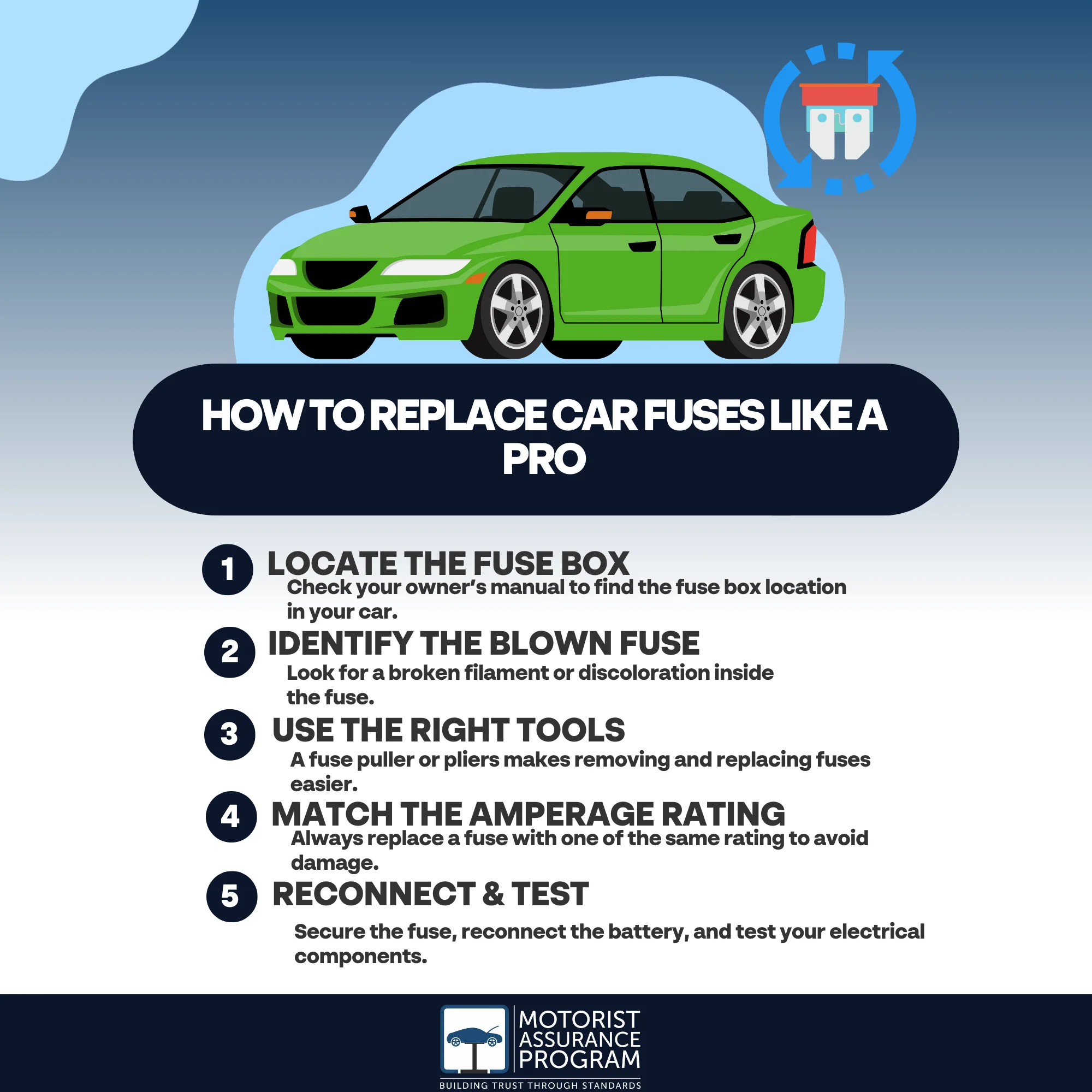
How to Safely Replace Car Fuses: A Step-by-Step Guide
Car fuses are small, inexpensive components that play a vital role in protecting your vehicle’s electrical system. These little protectors prevent damage from overloads and short circuits. When a fuse blows, it cuts off power to a specific circuit, preventing potential fires or damage to sensitive electronics.
Knowing how to safely replace a car fuse is a valuable skill that can save you time, money, and a trip to the mechanic. This comprehensive guide will walk you through the process step-by-step, ensuring you can handle this common car maintenance task with confidence.
Why Fuses Blow
Before diving into the replacement process, it’s helpful to understand why fuses blow in the first place:
- Overload: This occurs when a circuit is drawing more current than it’s designed to handle. This can happen if you plug in too many accessories, use a device that’s drawing excessive power, or if there’s a problem with the wiring.
- Short Circuit: A short circuit happens when a live wire comes into contact with a ground wire, creating a direct, low-resistance path for electricity. This results in a sudden surge of current that can quickly blow a fuse.
- Age and Wear: Like any component, fuses can degrade over time due to heat and vibration. This can make them more susceptible to blowing, even under normal operating conditions.
Safety First: Essential Precautions
Working with electricity always involves a degree of risk. Before you start, take these precautions:
- Turn Off the Ignition: The first and most important step is to turn off your car’s ignition and remove the key. This will prevent any accidental electrical surges or shorts while you’re working.
- Consult Your Owner’s Manual: Your owner’s manual is your best friend when it comes to car maintenance. It contains specific information about the location of your fuse boxes, fuse diagrams, and the correct amperage ratings for each fuse.
- Use the Right Tools: You’ll need a few basic tools, including:
- Fuse puller (often found in the fuse box)
- Replacement fuses of the correct amperage
- Flashlight or work light
- Multimeter (optional, for testing fuses)
- Wear Safety Glasses: Although the risk is low, wearing safety glasses will protect your eyes from any potential sparks or debris.
- Work in a Well-Lit Area: Good lighting is essential for seeing what you’re doing and avoiding mistakes.
- Don’t Replace with a Higher Amperage Fuse: This is a critical safety rule. Never replace a blown fuse with one that has a higher amperage rating. Doing so can overload the circuit and cause serious damage, including a fire. Always use a fuse with the exact same amperage.
Step-by-Step Fuse Replacement Guide
Now that you’re prepared, let’s walk through the fuse replacement process:
-
Locate the Fuse Box: Most cars have at least two fuse boxes. One is typically located under the dashboard, and the other is usually in the engine compartment. Consult your owner’s manual to find the exact location of each fuse box.
-
Open the Fuse Box: The fuse box cover is usually held in place by clips or screws. Gently remove the cover to access the fuses.
-
Identify the Blown Fuse:
- Fuse Diagram: Use the fuse diagram located on the fuse box cover or in your owner’s manual to identify the fuse that corresponds to the malfunctioning component (e.g., headlights, radio, power windows).
- Visual Inspection: Look for a fuse that has a broken filament or a dark, burned appearance. The filament is the thin wire inside the fuse that carries the electrical current.
- Fuse Tester/Multimeter (Optional): If you’re unsure whether a fuse is blown, you can use a fuse tester or multimeter to check for continuity. A good fuse will have continuity, while a blown fuse will not.
-
Remove the Blown Fuse:
- Fuse Puller: Use the fuse puller to grip the fuse and gently pull it straight out of the fuse box. Avoid using pliers or other tools that could damage the fuse box or surrounding components.
- Hand Removal (If Necessary): If a fuse puller isn’t available, you can carefully use your fingers to remove the fuse. Be gentle and avoid bending the fuse.
-
Install the New Fuse:
- Match the Amperage: Make sure the replacement fuse has the exact same amperage rating as the blown fuse. The amperage rating is usually printed on the fuse itself.
- Insert the Fuse: Align the new fuse with the empty slot in the fuse box and gently push it in until it’s fully seated.
-
Test the Circuit: Turn on the ignition and test the component that was malfunctioning (e.g., headlights, radio, power windows). If the component now works, you’ve successfully replaced the fuse.
-
Replace the Fuse Box Cover: Once you’re finished, replace the fuse box cover to protect the fuses from dust, moisture, and accidental damage.
What to Do If the Fuse Blows Again
If the new fuse blows immediately or shortly after being replaced, it indicates a more serious problem in the circuit. This could be a short circuit, an overloaded circuit, or a faulty component. In this case, it’s best to consult a qualified mechanic to diagnose and repair the problem.
Tips and Tricks
- Keep Spare Fuses: Always keep a selection of spare fuses in your car, so you’re prepared for unexpected fuse failures.
- Label Your Fuses: If your fuse box diagram is unclear, consider labeling the fuses yourself with a permanent marker.
- Take a Picture: Before removing any fuses, take a picture of the fuse box with your phone. This can be helpful if you accidentally remove multiple fuses and need to remember their correct locations.
- Don’t Ignore Blown Fuses: Ignoring a blown fuse can lead to further damage to your car’s electrical system. Replace blown fuses as soon as possible.
When to Seek Professional Help
While replacing a car fuse is a relatively simple task, there are times when it’s best to seek professional help:
- If you’re not comfortable working with electricity.
- If you can’t locate the blown fuse.
- If the fuse blows repeatedly after being replaced.
- If you suspect a more serious electrical problem.
Conclusion
Knowing how to safely replace car fuses is a valuable skill that can save you time and money. By following the steps outlined in this guide and taking the necessary safety precautions, you can confidently handle this common car maintenance task. Remember to always consult your owner’s manual, use the correct tools, and never replace a fuse with a higher amperage rating. If you’re ever unsure about anything, don’t hesitate to seek professional help.
